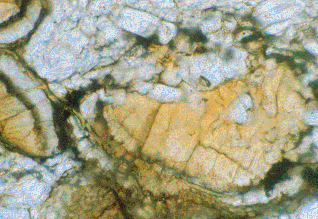Martian Meteorites and Fossil Martians
1996: Team of NASA scientists made the following claim:
A meteorite which came
from Mars has signs of fossilized bacterial life.
Wow.
Alan Hills 840001

This meteorite had chondrules, deposits which form when
the environment a rock lives in changes. The scientists said these chondrules
formed when water seeped through the rock in its early history on Mars.

Around these chondrules, they found evidence for
-
organic material (materials
known as PAHs - polycyclic aromatic hydrocarbons),
-
signs of magnetite (often
associated with Earth bacteria and their interaction with the Earth's magnetic
field), and most amazingly,
-
features which looked like fossilized
worms:


If someone came up to you
and said that, what questions would you want answered before you believed
them?
Is the rock really from Mars?
Yes. Absolutely.
-
It is chemically similar to a handful of odd meteorites which
are not like the vast quantities of normal meteorites we find.
-
These meteorites are igneous rock -- signs of volcanic activity.
-
These rocks have trapped gases which
are identical to the atmosphere Viking found on Mars.
Age dating of the rock suggests
-
it was originally formed 4.6 billion years ago.
-
the carbonate inclusions date from 3.6-4.0 billion years.
-
16 million years ago, the rock was ejected from Mars in an
impact
-
13,000 it landed in Antarctica
-
14 years ago it was found.
Could the evidence seen in
ALH840001 be produced by chemical processes?
Yes. Absolutely.
-
PAHs run around throughout space. In
comets, dust clouds, etc. Very common.
-
Magnetite is a common mineral; analysis
of the structure of magnetite found in ALH840001 suggests it is inorganic.
-
The "worms" could easily be mineral-like
platelets in the meteorite viewed edge on.
Why is it hard to envision
the evidence in ALH840001 as biological?
-
Carbonate deposits can easily form in shock heated rock at
700K -- not conducive to life.
-
The structures are 10-20 times smaller than similar "micro
fossils" seen on the earth. The smaller objects are probably too small
to support DNA: microfossils 20nm; cell walls each 5nm -- not enough room
left over for DNA!
-
Magnetite in Earth bacteria is due to interactions with the
Earth's magnetic field -- Mars has no magnetic field. Why would the Mars
bacteria excrete magnetite?
Final thoughts
-
Timing: NASA push for
missions to Mars
-
Scientific community:
vast majority of astronomers do not believe the claims are valid.
-
Carl Sagan: Extraordinary
claims require extraordinary evidence
More
on martian meteorites




